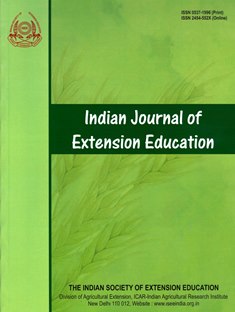Do Information Networks Enhance Adoption of Sustainable Agricultural Practices? Evidence from Northern Dry Zone of Karnataka, India
DOI:
https://doi.org/10.48165/IJEE.2023.59118Keywords:
Sustainable agricultural practices (SAP), Perception, Information, Social network analysis (SNA), Degree centrality, Social capital, Capacity buildingAbstract
The study aimed to analyze the perception of farmers towards sustainable agricultural practices (SAPs) and identify social networks using primary data collected randomly from 300 farmers of the northern dry zone of Karnataka. Five-point Likert scale was used to analyze the perception of farmers towards SAPs and open-source software named “Gephi” was used to map farmers’ social networks. Farmers’ perceptions towards SAPs were poor and only one in eight respondents reported high perception towards SAPs. Comparatively, large farmers had better perception towards SAPs and had better access to capacity building (extension contact and farm events) than the small and marginal farmers. Social capital (neighbor, progressive and relative farmers) had also played an important role in spreading SAPs related information among the farmers. However, local input dealers failed to be key informants and hardly disseminated information regarding SAPs. Government extension officials were the dominant informants on SAPs. Given the low level of adoption of SAPs in the study area, exploiting the potential of ICTs, training local input dealers, capacity building of the farmers and effective utilization of social capital are the suggested policy options to enhance the adoption of SAPs.
Downloads
References
Adhiguru, P., Birthal, P. S., & Kumar, B. G. (2009). Strengthening pluralistic agricultural information delivery systems in India. Agricultural Economics Research Review, 22(347-2016-16740), 71-80.
Babu, S. C., Glendenning, C. J., Asenso-Okyere, K., & Govindarajan, S. K. (2011). Farmers’ information needs and search behaviors: Case study in Tamil Nadu, India. Discussion Paper. International Food Policy Research Institute. (No. 1007-2016-79468).
Baker, T. A. (2011). Lessons for the potential use of contract farming with small land holding farmers in Myanmar. Vahu Development Institute pp. 1-14.
Bhagat, G. R., Nain, M. S., & Nanda, R. (2004). Information sources for agricultural technology. Indian Journal of Extension Education, 40(1&2), 111-112.
Doss, C. R. (2006). Analyzing technology adoption using microstudies: limitations, challenges, and opportunities for improvement. Agricultural Economics, 34(3), 207-219.
Garforth, C. (2011). Education, Training and Extension for Food Producers. Science Review: SR16B. Foresight Project on Global Food and Farming Futures. London: Government Office for Science. http://www.bis.gov.uk/assets/bispartners/foresight/docs/ food-and-farming/science/11-562-sr16b-education-training extension-for-food-producers.pdf.
Gupta, B. K., Mishra, B. P., Singh, V., Patel, D., & Singh, M. P. (2020). Constraints faced by vegetable growers in adoption of IPM in Bundelkhand Region of Uttar Pradesh. Indian Journal of Extension Education, 56(4), 92-97.
Kumar, S., Raizada, A., & Biswas, H. (2014). Prioritising development planning in the Indian semi-arid Deccan using sustainable livelihood security index approach. International Journal of Sustainable Development & World Ecology, 21(4), 332-345.
Landherr, A., Friedl, B., & Heidemann, J. (2010). A Critical Review of Centrality Measures in Social Networks. Business and Information Systems Engineering, 2(6), 371–385. doi:10.1007/ s12599-010-0127-3.
MANAGE (2012). Progress under diploma in agricultural extension services for input dealers as on 01-04-2011.www.manage.gov.in/ daesi/daesi-distyearwiselist.pdf
Ministry of Agriculture and Farmers’ Welfare (2017). Doubling Farmer Income Report. https://agricoop.gov.in/sites/default/files/ DFI%20Volume%201.pdf.
Ministry of Chemicals and Fertilizers (2022). Prime Minister Inaugurates 600 Pradhan Mantri Kisan Samruddhi Kendras [press release]. https://pib.gov.in/PressReleasePage.aspx?PRID=1868496
Mittal, S., & Mehar, M. (2012). How mobile phones contribute to growth of small farmers? Evidence from India. Quarterly Journal of International Agriculture, 51(892-2016-65169), 227-244.
Mittal, S., & Mehar, M. (2016). Socio-economic factors affecting adoption of modern information and communication technology by farmers in India: Analysis using multivariate probit model. Journal of Agricultural Education and Extension, 22(2), 199- 212.
Nain, M. S., & Chandel, S. S. (2013). Knowledge vis a vis adoption of agri horti system in Doda district of J&K state. Indian Journal of Extension Education, 49(1&2), 105-109.
Nain, M. S., Singh, R., Mishra, J. R., & Sharma, J. P. (2015). Utilization and linkage with agricultural information sources: a study of Palwal district of Haryana state. Journal of Community Mobilization and Sustainable Development, 10(2), 152-156.
Nedumaran, S., & Ravi, N. (2019). Agriculture extension system in India: a meta-analysis. Research Journal of Agricultural Sciences, 10(3), 473-479.
Panda, S., Modak, S., Devi, Y. L., Das, L., Pal, P. K., & Nain, M. S. (2019). Access and usage of Information and Communication Technology (ICT) to accelerate farmers’ income. Journal of Community Mobilization and Sustainable Development, 14(1), 200-205.
Panja, A., Gowda, N. S., Kusumalatha, D. V., & Jayasingh, D. K. (2022). Role performance of agricultural input dealers in agro advisory services in West Bengal. Indian Journal of Extension Education, 58(3), 8-13.
Raina, V., Nain, M. S., Hansra, B. S., & Singh, D. (2011). Marketing behaviour and information sources utilization pattern of flower
growers. Journal of Community Mobilization and Sustainable Development, 6(2): 180-184.
Ravikumar, K., Nain, M. S., Singh, R., Chahal, V. P., & Bana, R. S. (2015). Analysis of farmers’ communication network and factors of Knowledge regarding agro metrological parameters. Indian Journal of Agricultural Sciences, 85(12), 1592-1596.
Sajesh, V. K., & Suresh, A. (2016). Public-sector agricultural extension in India: A note. Review of Agrarian Studies, (62369-2020- 2041).
Singh, A. K., De, H. K., & Pal, P. P. (2016). Training needs of agro input dealers in South 24 Parganas District of West Bengal. Indian Research Journal of Extension Education, 15(2), 7-10.
Wang, S. (2004). One hundred faces of sustainable forest management. Forest Policy and Economics, 6(3-4), 205-213.
Downloads
Published
Issue
Section
License

This work is licensed under a Creative Commons Attribution-NonCommercial-NoDerivatives 4.0 International License.

